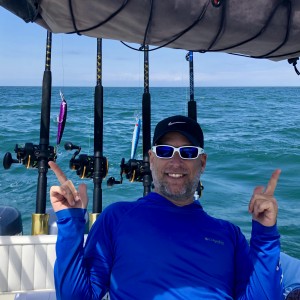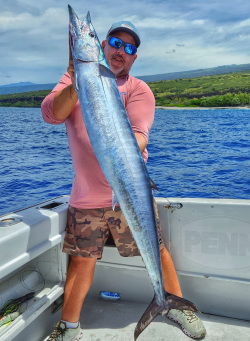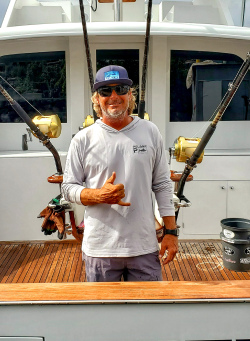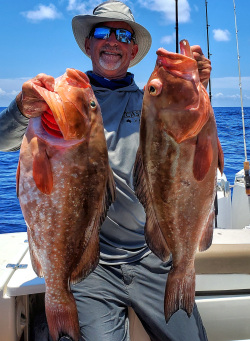Discover red snapper, grouper, and other species by bottom fishing. Use a "In The Spread Bottom Fishing for Red Snapper" video for detailed tactics, rig setups, and fish preservation tips. If hard bottom isn't marked, drop baits and observe if you get bitten. The video covers rigs, baits, fishing tactics, drag management, and fish preservation.
Bottom Fishing - Red Snapper with Kevin Adney
(00:22:20)- The importance of good structure for successful red snapper fishing
- Bait placement and the game of feel when bottom fishing
- Rigs, baits, and hook sizes for targeting red snapper
- Baiting options and the advantages of live bait
- Regulations, fish care, and preserving your catch
Bottom fishing for red snapper is a challenging and rewarding experience for anglers along Florida's Gulf Coast. Red snapper, much like grouper, are structure-oriented fish that require specific techniques and tactics to catch successfully. In this article, we'll explore the essentials of bottom fishing for red snapper, including the importance of good structure, bait placement, rigs, baits, and more.
The Importance of Good Structure
When it comes to red snapper fishing, finding the right structure is paramount. These fish are highly dependent on their habitat, which consists of reefs, rock piles, ledges, and other hard bottom structures. Red snapper use these areas for protection, feeding, and reproduction.
As an angler, your success in catching red snapper is directly tied to your ability to locate and fish on these specific structures. Without being on the right spot, you could spend hours fishing with little to no results. This is why it's essential to do your research, study bathymetric maps, and use your electronics to pinpoint the best areas to drop your baits.
Once you've found a promising structure, the next challenge is to position your boat correctly and present your baits as close to the structure as possible without getting snagged. Red snapper are notorious for darting back into the safety of the rocks when hooked, so it's crucial to maintain a tight line and be ready to reel in your catch as soon as you feel a bite.
The importance of structure in red snapper fishing cannot be overstated. By focusing your efforts on the right reefs, rock piles, and ledges, you'll greatly increase your chances of landing these highly sought-after bottom fish. So, the next time you head out for a day of **snapper fishing**, remember: it's all about the structure.
Nothing is more important in bottom fishing for red snapper than being on good structure. Snapper won't venture far from the protection of the reef or other hard bottoms.
Kevin AdneyThe Game of Feel
Bottom fishing for red snapper is an art that requires finesse, patience, and a keen sense of feel. One of the most critical aspects of this technique is the placement of your bait in relation to the structure. Red snapper are structure-oriented fish, meaning they rarely venture far from the safety of their rocky homes. To entice them to bite, you must present your bait as close to the structure as possible without getting snagged.
This is where the delicate game of feel comes into play. As you lower your bait to the bottom, you must be able to sense when it makes contact with the structure. This requires a sensitive rod and a light touch, allowing you to feel the subtle bumps and taps that indicate you're in the right spot.
Once your bait is in position, the waiting game begins. Red snapper are cautious feeders, and they may take some time to investigate your offering. As you wait, keep your line tight and your senses sharp. The bite of a red snapper can be subtle, often feeling like a slight tap or a gradual increase in pressure.
When a red snapper does take your bait, it's essential to react quickly. These fish are powerful fighters, and their first instinct is to head straight back to the safety of the rocks. If they make it back to their home, the chances of getting them out are slim to none. This is where your skills as an angler come into play.
As soon as you feel the bite, reel in any slack line and set the hook with a firm, upward motion. Keep your rod tip high and your drag set to a moderate level, allowing the fish to take line when needed but not giving it too much freedom. With a combination of skill, patience, and a little bit of luck, you'll be able to keep that red snapper from reaching its rocky home and bring it up to the surface.
Bottom fishing for red snapper is a challenging and rewarding experience that requires a mastery of the game of feel. By placing your bait close to the structure, sensing the bite, and reacting quickly, you'll be well on your way to filling your cooler with these delicious bottom fish. So, the next time you head out for a day of snapper fishing, remember: it's all about the feel.
Rigs, Baits, and Hook Sizes
When it comes to bottom fishing for gulf red snapper, using the right rigs, baits, and hook sizes can be the difference between a successful trip and a frustrating one. Two popular weight options for **snapper fishing** are the regular knocker rig and weights with swivels.
The regular knocker rig consists of a sinker sliding directly on the main line, followed by a short leader and a hook. This rig allows the bait to move freely and naturally, making it an attractive option for red snapper. The sinker's weight can be adjusted based on the depth and current, ensuring that your bait reaches the desired location.
Weights with swivels, on the other hand, offer a slightly different approach. In this rig, the weight is attached to a swivel, which is then connected to the leader and hook. The swivel helps prevent line twist and allows the bait to move more independently from the weight. This can be particularly useful when fishing in strong currents or when using live baits.
In addition to choosing the right weight, selecting the appropriate line, leader, and hook sizes is crucial. When fishing for bottom fish like red snapper, you'll want to use a strong, abrasion-resistant main line to withstand the rough structure and powerful fights. Monofilament or braided line in the 30-50 pound range is a common choice.
For leaders, many anglers opt for fluorocarbon material in the 40-80 pound range. Fluorocarbon is nearly invisible underwater and offers excellent abrasion resistance, making it a great choice for fishing around structure. Leader length can vary depending on the situation, but a general rule of thumb is to use a leader slightly shorter than the distance from your rod tip to the reel.
Hook size is another important consideration when targeting red snapper. While the ideal hook size can vary based on the size of the bait and the fish you're targeting, a good starting point is a 7/0 to 14/0 circle hook. Circle hooks are designed to catch in the corner of the fish's mouth, reducing the risk of gut-hooking and making it easier to release undersized fish.
Ultimately, the key to success when bottom fishing for gulf red snapper is to experiment with different rigs, baits, and hook sizes until you find the combination that works best for you. Don't be afraid to try new things and adjust your approach based on the conditions and the feedback you get from the fish. With the right gear and a little bit of persistence, you'll be well on your way to filling your cooler with these delicious bottom fish.
Baiting Options
When it comes to baiting options for red snapper fishing, both cut bait and live bait have their merits. Cut bait, such as squid, sardines, or mackerel, can be very effective for catching nice-sized red snapper. These baits are easy to acquire, store, and use, making them a popular choice among anglers.
Cut bait works well because it releases a strong scent trail that attracts fish from a distance. When chunked into smaller pieces, cut bait can also mimic the natural prey of red snapper, such as small baitfish or crustaceans. This can be particularly effective when fishing over structure, as the scent and small pieces of bait can draw the fish out from their hiding spots.
However, if you're looking to target larger, trophy-sized gulf snapper, live bait is often the way to go. Live baits, such as pinfish, croakers, cigar minnows or blue runners, offer a more natural presentation and can be more enticing to bigger, more cautious fish. The movement and vibrations of a live bait can trigger a red snapper's predatory instincts, making them more likely to strike.
One common strategy for bottom fishing fish like red snapper is to start with cut bait to get the bite going and then switch to larger live baits once the fish are actively feeding. This allows you to quickly establish a solid bite and then selectively target the larger fish in the area.
When using live bait, proper bait preparation is crucial. You'll want to make sure your baits are healthy, lively, and the appropriate size for the fish you're targeting. A good rule of thumb is to use baits that are roughly one-third to one-half the size of the fish you want to catch.
To keep your live baits in top condition, use a high-quality bait well or livewell with a good aeration system. Keep the water cool and clean, and avoid overcrowding the baits. When hooked, make sure to place the bait securely on the hook, typically through the nose or just behind the dorsal fin.
Both cut bait and live bait have their place in snapper fishing. Cut bait can be very effective for catching good numbers of red snapper, while live bait is often the key to landing larger, trophy-sized fish. By starting with cut bait and then switching to live bait once the bite is established, you can maximize your chances of success when bottom fishing for these highly sought-after gulf red snapper. Just remember, proper bait preparation is key to ensuring your baits are in top condition when they hit the water.
Regulations and Fish Care
Red snapper are a highly prized and heavily regulated species in the Gulf of Mexico. Due to their popularity and historical overfishing, the red snapper fishing season is often short and subject to change. This means that anglers must make the most of their limited fishing time and be prepared to handle their catch responsibly, whether in or out of season.
When fishing for bottom fish like red snapper out of season, it's crucial to know how to properly care for and release the fish to ensure their survival. One important technique is venting, which involves releasing the excess air from the fish's swim bladder that expands when the fish is brought up from deep water. To vent a fish, use a hollow needle or a venting tool to puncture the swim bladder, allowing the air to escape. This enables the fish to regain its buoyancy and swim back down to the depths.
If you're fortunate enough to be fishing during the red snapper season, proper fish care is still essential to maintain the quality of your catch. The key is to chill your fish as quickly as possible to prevent spoilage and preserve the delicate flavor of the meat.
One effective method is to create a slurry of ice and seawater in a large cooler. As soon as you catch a legal-sized red snapper, place it in the slurry to rapidly bring down its temperature. This not only keeps the fish fresh but also helps to prevent the meat from drying out or losing its texture.
In addition to proper chilling, it's important to handle your catch carefully to avoid bruising the meat or damaging the skin. Use a soft, wet cloth or glove to grip the fish, and avoid using a gaff or other sharp objects that can puncture the flesh.
By following these simple guidelines for fish care, you can ensure that your red snapper fishing experience is both enjoyable and sustainable. Whether you're practicing catch-and-release or bringing home a delicious meal, proper fish handling is essential for preserving the health of the fishery and the quality of your catch.
What is the best bait for red snapper?
Cut bait can be effective for catching red snapper, but live bait often produces larger fish. Popular live baits include pinfish, croakers, and cigar minnows.
What is the minimum size limit for red snapper in the Gulf of Mexico?
At this time, the minimum size limit for red snapper in the Gulf of Mexico is 16 inches total length. Regulations change, so stay on top of them.
How deep do you need to fish for red snapper?
Red snapper can be found at depths ranging from 30 to 620 feet, but they are most commonly caught between 60 and 200 feet deep.
What is the best time of year to fish for red snapper?
The best time to fish for red snapper is typically during the summer months when the season is open. However, the exact dates vary by state and can change from year to year.
What type of hook is best for catching red snapper?
Circle hooks are often recommended for catching red snapper, as they help minimize deep hooking and improve the chances of a successful release for undersized fish. 7/0-14/0 hooks are recommended.
Keep Learn and Keep Catching
By mastering the techniques and tactics discussed in this article, you'll be well on your way to a successful day of bottom fishing for red snapper. Remember, there's always room for expanding your knowledge and improving your skills when it comes to fishing for bottom fish like the prized gulf red snapper.
User Reviews












